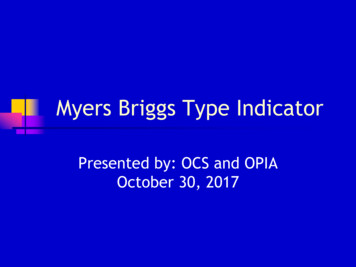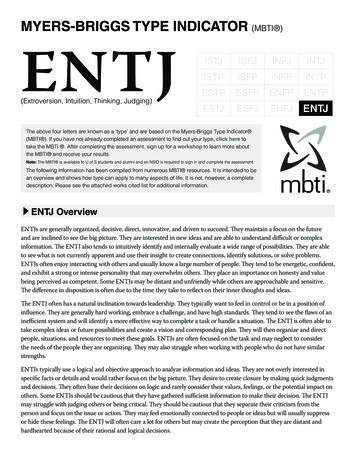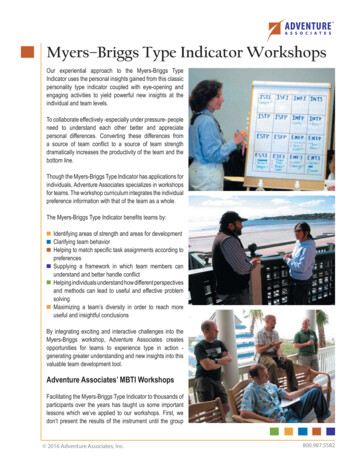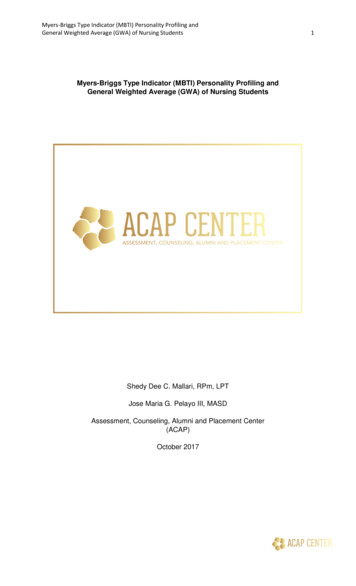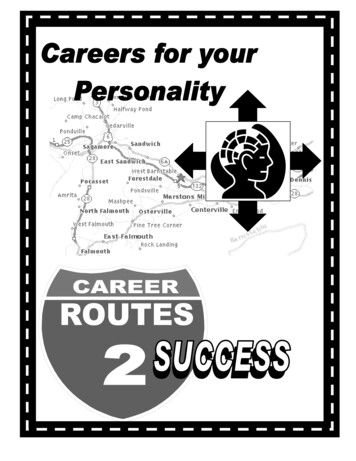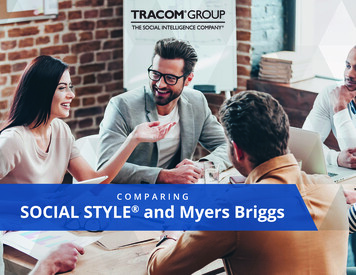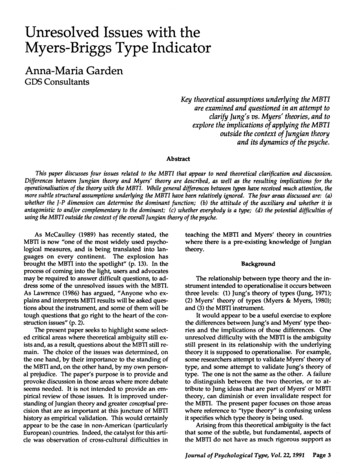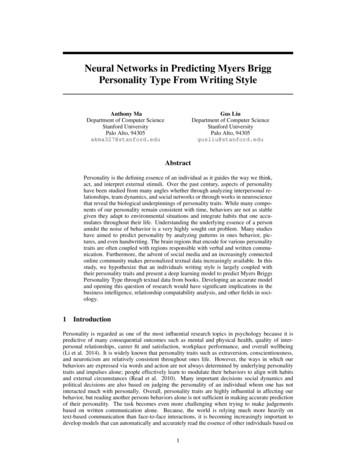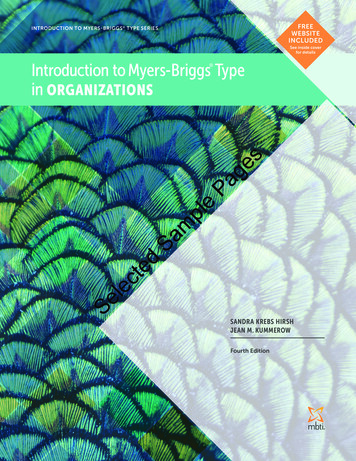
Transcription
FREEWEBSITEINCLUDEDINTRODUCTION TO MYERS-BRIGGS TYPE SERIESSee inside coverfor detailsIntroduction to Myers-Briggs Typein ORGANIZATIONSSelectedSamplePages SANDRA KREBS HIRSHJEAN M. KUMMEROWFourth Edition
ContentsWHAT IS THE MBTI ASSESSMENT?1TYPE DYNAMICS: ORDER OF THE MENTAL PROCESSES26The MBTI Preferences3Favorite Process26Effects of Extraversion and Introversionon the Favorite Process26Second Process265The Four Quadrants of the Type Table6The Balancing Role of the Second Process27The Four Process Pairs7Third Process27Another Popular Grouping of Preferences827Example28A Note on Introversion28A Note on the Fourth Process29DECISION MAKING USING TYPE PREFERENCES3013Using the Problem-Solving Model3014Using Your Natural Strengths31ISTP11ESTP12SaISFJPa10pleISTJm9geFourth ProcessDESCRIPTIONS OF THE 16 TYPESESTJsPREFERENCE P20ENFJ21INTJ22INTP23ENTP24ENTJ25
What Is the MBTI Assessment? This booklet is designed to help youits opposite. Your four preferences—your choice fromunderstand your results on the Myers-Briggseach pair of opposites—make up your four-letterType Indicator (MBTI ) assessment and howMyers-Briggs type. The four pairs of preferences describefour different aspects of personality, as shown below.you can use them to optimize success at work.EXTRAVERSION (E) or INTROVERSION (I)Opposite ways to direct and receive energyThe MBTI assessment provides a useful method forsunderstanding people by identifying 16 Myers-Briggs personality types. The personality types arise from thegeSENSING (S) or INTUITION (N)*Opposite ways to take in informationfour pairs of opposite preferences shown at right. EachPapreference is indicated by a letter.THINKING (T) or FEELING (F)Opposite ways to decide and come to conclusionspreferences at least some of the time, people typicallyThe way you direct and receive energyEXTRAVERSIONSaTHE FOUR MYERS-BRIGGS PREFERENCE PAIRSJUDGING (J) or PERCEIVING (P)Opposite ways to approach the outside worldmfind one in each pair more comfortable and natural thanpleAlthough each of us can and does use all of theINTROVERSIONPeople who prefer Introversion tend to direct theirenergy toward their inner world and get energizedby reflecting on their ideas, memories, and experiences.ctedPeople who prefer Extraversion tend to direct theirenergy toward the outside world and get energizedby interacting with people and taking action.SENSINGleThe way you take in informationSePeople who prefer Sensing tend to take in informationthat is real and tangible. They focus mainly on whatthey perceive using the five senses.INTUITION *People who prefer Intuition tend to take in informationby seeing the big picture. They focus mainly on thepatterns and interrelationships they perceive.The way you decide and come to conclusionsTHINKINGFEELINGPeople who prefer Thinking typically base theirdecisions and conclusions on logic, with accuracyand objective truth the primary goals.People who prefer Feeling typically base their decisionsand conclusions on personal and social values, withunderstanding and harmony the primary goals.The way you approach the outside world*JUDGINGPERCEIVINGPeople who prefer Judging typically approach theworld with decisiveness and tend to like planningand closure.People who prefer Perceiving typically approach theworld with flexibility and tend to like spontaneity andopenness.To avoid duplication and confusion, the letter “N” is used for Intuition because the letter “I” signifies Introversion.1
PREFERRED METHODS OF COMMUNICATIONEXTRAVERSIONINTROVERSIONCommunicate with energy and enthusiasmKeep energy and enthusiasm insideRespond quickly without long pauses to thinkPause and reflect before respondingConverse about people, things, and ideas in the outside worldThink through ideas, thoughts, and impressionsSometimes need to moderate your deliverySometimes need to be drawn outSeek opportunities to communicate with groupsSeek opportunities to communicate one-to-oneLike at least some communication to be face-to-faceLike at least some communication to be in written formatIn meetings, like talking out loud to build your ideasIn meetings, verbalize ideas that have been thought throughSENSINGINTUITIONLike evidence (facts, details, and examples) presented firstLike global schemes, with broad issues presented firstWant practical and realistic applications shown, withrelationships between the facts clearly explainedWant to consider future possibilities and challengesRely on direct experience to provide information andanecdotesRely on a roundabout approach in conversationsUse insights and imagination as information and anecdotessLike suggestions to be novel and unusualUse an orderly, step-by-step approach in conversationsgeRefer to general conceptsLike suggestions to be straightforward and feasibleIn meetings, use the agenda as a starting pointPaRefer to specific examplesIn meetings, follow the agendaFEELINGpleTHINKINGPrefer to be personable and in agreementWant the pros and cons of each alternative to be listedAre convinced by cool, impersonal reasoningPresent goals and objectives firstUse emotions and feelings as secondary datactedIn meetings, seek involvement with the task firstleJUDGINGWant to agree on schedules, timetables, and reasonabledeadlinesSeWant to know an alternative’s impact on people and valuesCan be appreciative and accepting of othersSaCan be intellectually critical and objectivemPrefer to be brief and conciseAre convinced by personal authenticityPresent points of agreement firstConsider logic and objectivity as secondary dataIn meetings, seek involvement with people firstPERCEIVINGAre willing to discuss timetables but resist tight deadlinesand unchangeable schedulesDislike surprises and want advance warningEnjoy surprises and adapt to last-minute changesExpect others to follow through, and count on that happeningExpect others to respond to situational requirementsState your positions and decisions as finalPresent your views as tentative and modifiableWant to hear about results and achievementsWant to hear about options and opportunitiesFocus on purpose and directionFocus on autonomy and flexibilityIn meetings, concentrate on completing the taskIn meetings, pay attention to how things are proceedingSource: Adapted from Talking in Type by Jean M. Kummerow, Center for Applications of Psychological Type, 1985.4
Preference GroupingsAs mentioned earlier in this booklet, your fourTYPE TABLEpreferences—your choice from each pair ofopposites—make up your four-letter MyersBriggs type. When the eight preferences inthe four pairs of opposites are combined in allspossible ways, 16 four-letter types result.geThese 16 types are displayed on a type table, as shownPahere.pleThe type table is arranged as follows:EXTRAVERSION (E) in the two bottom rowsmINTROVERSION (I) in the two top rowsINTUITION (N) in the two right columnsFEELING (F) in the two inner columnsedTHINKING (T) in the two outer columnsSaSENSING (S) in the two left columnsin different ways. The following sections show threecommon groupings of the preferences.ctJUDGING (J) in the top and bottom rowsType professionals like to group the preferences togetherSelePERCEIVING (P) in the two inside rows5
ENFPs are enthusiastic, insightful, innovative, versatile, andtireless in pursuit of new possibilities. They enjoy working onteams to bring about change related to making things betterfor people.ExtraversionIntuitionFeelingPerceivingWork StyleLeadership Style See the need for and initiatechange Take charge of the start-up phase Share their energy and enthusiasm Focus on possibilities, especiallyfor people Communicate readily, possiblybecoming spokespersons forworthy causes Energize and persuade othersthrough their enthusiasm Make an effort to include andsupport people while allowingfor autonomy Appreciate and acknowledgeothers Focus on what motivates peopleand encourage them to actges Bring creativity and imaginationto projects and actionsProblem-Solving ApproachPaWork Environments Include imaginative people focusedon possibilitiesple Allow for sociability and flair Foster participation with differentkinds of people and perspectivesm Offer variety and challengeSa Encourage sharing ideas Are flexible, casual, andunconstraineded Mix in fun and enjoymentFiSecondTThirdSiFourthSee ”Type Dynamics: Order ofthe Mental Processes“ later in thisbooklet for further explanation.* May need to apply logicdispassionately (T) and considerthe relevant facts and details (S) foroptimal resultsLearning Style Active, experiential, andimaginative Interesting, whether or not ithas practical applicationsleFirstSeNectType Dynamics* Want to explore creativepossibilities for growth (N) thatfit with their values (F)Potential PitfallsSuggestions for Development May want to move on to new ideasor projects without finishing whatthey’ve already started May need to set priorities based onwhat is most important and thenfollow through May overlook relevant facts anddetails May need to pay attention tokey details and then stay focusedon them May overextend themselves and tryto do too much May procrastinate while searchingfor the best possible answer May need to screen tasks and sayno rather than try to do them all,no matter how appealing they maysound May need to use project- and timemanagement skills to meet goals20
understand your results on the Myers-Briggs Type Indicator (MBTI ) assessment and how you can use them to optimize success at work. The MBTI assessment provides a useful method for understanding people by identifying 16 Myers-Briggs personality types. The personality types arise from th
